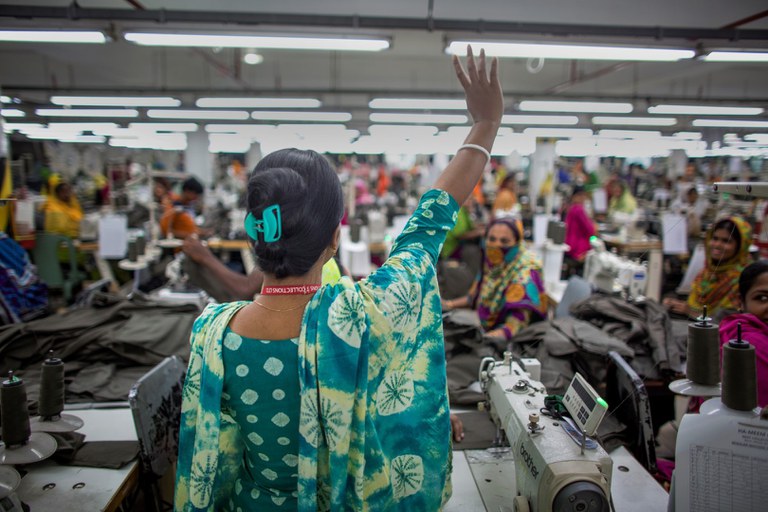"Good policy won’t be helpful unless there is regular monitoring, follow-up, guidance and reporting to ensure effective implementation"
Smita, before talking about you and HERproject, I would like to ask two more general questions about the garment sector in Bangladesh. Bangladesh is the world's second largest exporter of garments after China. The government is pursuing the goal of further growing the industry. In doing so, do you think the government is placing equal focus on the well-being of workers, who are the backbone of this industry?
According to the Bangladesh Government’s A2i programme and the ILO’s recent report, by 2030, 60% of the women workers will lose their job due to automation in the garment sector. The expansion of technology is in progress globally and Bangladesh doesn’t really have any other option but to embrace it. Government and employers’ associations are currently working toward worker wellbeing such as paying wages digitally, women empowerment programs at the factories, strengthening healthcare services for the workers, mental health well-being programs, etc. Though a long-term plan to address the needs and welfare of the employees in the face of automation is yet to be made, policymakers are working on plans to launch initiatives to upskill garment workers.
Since the Rana Plaza tragedy, legislation and its enforcement have evolved significantly in many areas in Bangladesh. These include union representation, minimum wage, and job security for RMG workers. However, ILO’s International Labour Standards are still not being met in many factories. What policies and frameworks are needed to change this in the future?
Government, employers’ associations, worker unions and development organizations should work together to review the current labour law and legislations. Regular consultations with workers of all genders are required so that their voices are heard and needs are reflected. Workers need to be openly communicated with about policies being put in place. Good policy won’t be helpful unless there is regular monitoring, follow-up, guidance and reporting to ensure effective implementation.
You are the Country Representative for HERproject in Bangladesh. Can you tell us a bit about your work and the project?
My role is to lead all the HERproject program activities in Bangladesh including program development, monitoring, and quality control. In addition, I represent HERproject in seminars/meetings, engage with stakeholders such as brand members, local NGOs, garment factories, UN agencies and government bodies.
In Bangladesh, we are implementing HERhealth, HERfinance Digital Wages, HERrespect, and HERessentials. Through HERhealth, we build the capacity of women workers to share resources on various health topics that are immediate need of the workers such as sexual and reproductive health, STIs, family planning, maternal health, nutrition, childcare, occupational health and safety, personal hygiene, etc. Our HERfinance Digital Wages program supports female and male workers to digitize their wages and provides financial capability training to the workers.
HERrespect promotes gender equality in the workplace to address and prevent gender-based violence at the factories. HERessentials provides critical information to vulnerable female and male workers and managers in global supply chains during times of crisis, including information on health, financial resilience, and tools for building harmonious relationships and handling stress. In Bangladesh, we have worked with more than 230 garment factories in past 12 years.
What are the biggest problems workers, in particular women, are currently facing in the garment sector in Bangladesh?
From my experience, the most pressing issues for women are inequalities at work and at home, a lack of confidence and of opportunities for career progression. Women also face health issues related to reproductive health and occupational health problems, sexual harassment, and other forms of abuse at home and at the factories. These are in no way inclusive of the many, complex issues women face in Bangladesh.
Why do you believe that women in global supply chains have the potential to be powerful agents for positive change in workplaces and in society? And what actions can lead to this happening in reality?
Social norms, systems and policies are formed in ways that create barriers for women from acting freely and autonomously. It's important to create equal paths for women to participate in decision and policy making and give women from underprivileged groups opportunities to lead. Women can be leaders and problem solvers and should be given the chance to do so. Systemic issues take a long time to change, but the first step is for decision makers to adopt a mindset where women have the potential to contribute more to society, and only need equal rights and the right opportunities.
How does HERProject tackle these problems? What concrete support do you provide to women workers?
HERproject creates agents of change with women workers who act as peer educators and change makers in the workplaces and in the communities. Effective communication skills, soft skills and confidence building are the core elements of HERproject. We support workplaces in building up their women workers further and advocate for the empowerment and well-being of women within the workplace. We motivate and empower women through knowledge, resources and hands on capacity building so that they can bring the changes in their lives. We also provide them resources and guidance on how they can motivate their colleagues and share knowledge within the factories and with their communities.
For those who are not familiar with the topic of Wage Digitization, can you give us a brief insight and tell us what the HERfinance Digital Wages program is all about?
HERfinance Digital Wages program supports women and men workers and factory management to digitize the wages of the workers. This means that instead of paying the monthly wages in cash, employers pay wages into the workers’ bank or Mobile Financial Services (MFS) accounts. We use six training modules to build the capacity of women workers which are: “Introduction to digital payrolls”, "How to use digital accounts”, "Financial planning”, "Budgeting”, "Saving”, and "Talking about finances with family”. We guide factory management on how they can select a financial service provider and how can they change their payroll system. We support workers in opening their accounts, as many of them don’t know the process and don’t have an account. We also support workers during paydays on how they can use their account to make transactions. All HERfinance training materials including modules, tech learning tools, posters, and jingles are available on our HERproject website: https://herproject.org/resources/herfinance.
Digital financial services are said to support dignity, security, and empowerment for women workers. How does this work?
Digital financial services with financial capability training can promote dignity, security and empowerment of women. Digital financial services alone can’t bring the positive changes. HERfinance supported 150,000 workers, of which more than half were women, to get paid into their accounts and provided financial capability training as well. As a result, women trained are now making an average of eight transactions a month digitally, one in five women trained are making joint decisions about the use of their salary, one in eight women trained have increased confidence in meeting any unexpected expenses and one in five workers trained have started saving regularly.
Why is cash inefficient, especially during crises like the Covid-19 pandemic?
During COVID – 19, when lockdown happened in Bangladesh all the garment factories had to close their operations. As a result, workers and factory management were anxious about how to distribute salaries during lockdown. The factories who already had a digital system in place, didn’t face much difficulty in disbursing the payment because workers had digital accounts and factories just transferred the payment.
The cash-based payroll factories faced multiple challenges including payment delays, workers having to come back from their villages to the factories to receive payment, having to transport physical cash during lockdown etc. Also, to avail themselves of the Government's bailout package factories were asked to digitize first because factories can only disburse money from the package through a bank transfer or MFS. Cash-based factories had to rush to open accounts for thousands of workers in a short period of time and faced significant difficulties doing so, while the already digitized factories did the disbursement smoothly.
In addition, during COVID-19, women workers who got paid in MFS accounts didn’t have to go to the agent to transfer money or to pay for their mobile bills. They could do it from home.
How can the HERfinance training help close the digital gender gap and better prepare women for the future?
HERfinance trainings teach women how to open an account and how to use the account. For many women, this is their first account. MFS accounts are on the phone and so during training, we also guide women on how they can use their phone properly. We have tablet-based tech learning tools that we use during the training sessions. The tech learning tools have quizzes, animation and films on the training topics. Women learn to use the tablet and the tech tool during the training. We build women’s confidence to use the devices, accounts and interact with modern technology.
Can you give us a practical example of the training that has helped women workers?
One example is during the training we demonstrate and then conduct hands-on activities on how to send money, cash out, buy mobile top ups and check balance using their accounts. Women factory workers are often afraid of using accounts and lack trust in the system. But when transactions are demonstrated practically and they make their first transaction in front of the trainer, their confidence grows.
The impact of the pandemic on the RMG sector in Bangladesh has been widely reported, including its heavy human toll. What is the current situation now, and what has the industry learned from this experience?
The current situation in the industry is leading to more orders from global buyers that are looking for skilled workers. Employers are reporting that there is a shortage of skilled workers in the industry. The major learning from the pandemic is that diversification is required so that the industry isn’t dependent on garments. Employers are thinking about how to create a more resilient business model.
Beyond short term relief measures passed during the pandemic, what structural or long-term changes do you see underway in Bangladesh (by government or industry stakeholders) to ensure the industry and its workforce are more resilient to future shocks? What more needs to be done?
Employers’ association made a public announcement of working towards 100% gender equality in the industry by 2030. Workers, industry stakeholders and employers talked about creating an emergency fund and providing insurance. A lot of talks have taken place regarding automation, where workers (especially women) will lose their jobs and what measures can be taken to upskill workers so they are not left jobless. In order to build resilience and leave no workers behind, government and other industry stakeholders need to develop an action plan on each of the issues and practical, proactive steps that will be taken by the industry as a whole.

Smita Nimilita leads the implementation of HERproject in Bangladesh. She also supports the development of HERfinance Digital Wages Program in other countries such as Egypt and Cambodia. Prior joining to HERproject, she was a research associate at Innovations for Poverty Action (IPA), a research and policy non-profit organization that discovers and promotes effective solutions to global poverty issues. She led various development research programs in Bangladesh, in collaboration with the academics from The World Bank Development Research Group, The University of Warwick, Harvard, and Oxford. She has robust experience working in the garment supply chain in the field of women’s empowerment, financial inclusion, health rights, and enterprise development.

